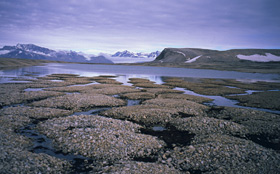 |
 |
 |
 Editorials | Environmental | December 2005 Editorials | Environmental | December 2005  
Study: Climate Change Could Melt Permafrost in Alaska
 Associated Press Associated Press


| | Permafrost earth that remains frozen year-round lies under much of Alaska, Canada and Siberia. It can be more than 1,000 feet deep on the Arctic slope. |
Anchorage, Alaska — Climate change could melt the top 11 feet of Alaska permafrost by the end of the century, according to a new study.

The federal study applied one supercomputer climate models to the future of permafrost.

Under the most extreme scenario outlined, warming temperatures could thaw the top 11 feet of permafrost near the ground surface in most areas of the Northern Hemisphere by 2100, altering ecosystems across Alaska, Canada and Russia.

"If that much near-surface permafrost thaws, it could release considerable amounts of greenhouse gases into the atmosphere, and that could amplify global warming," said lead author David Lawrence, with the National Center for Atmospheric Research. "We could be underestimating the rate of global temperature increase."

A permafrost researcher at the University of Alaska Fairbanks, however, disagrees that the thaw could be so large. Alaska's permafrost won't melt that fast or deep, said Vladimir Romanovsky, who monitors a network of permafrost observatories for the Geophysical Institute.

If air temperatures increase 2 to 4 degrees over the next century, permafrost would begin thawing south of the Brooks Range and start degrading in some places on Alaska's Arctic slope, he said. But a prediction that melting will reach deeply over the entire region goes too far, he said.

The computer climate model didn't consider some natural factors that tend to keep the permafrost cold, Romanovsky said. For example, deeper permafrost, largely untouched by recent warming at the surface, would have an influence.

Lawrence said he hopes to collaborate with Romanovsky to fine-tune future studies to deal with those deeper layers.

Permafrost earth that remains frozen year-round lies under much of Alaska, Canada and Siberia. It can be more than 1,000 feet deep on the Arctic slope.

Ground melting is only one clue that Arctic climate change may be speeding up. In September, the polar ice cap shrank to its smallest extent in 25 years of monitoring by satellite. Tundra has been greening up. NASA recently reported that 2005 may top 1998 as the Earth's warmest year on record. | 
 | |
 |



